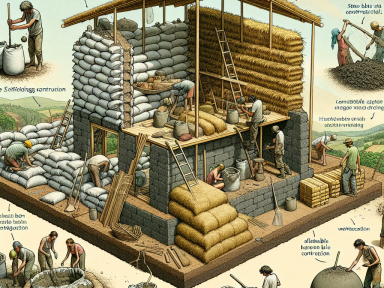Natural Building Techniques for High-Quality, Sustainable Homesteads
The times are changing and not necessarily for the better. Global crises, economic instability, dwindling resources…the list goes on. Amidst all this, one thing is clear – the old ways aren’t working anymore. It’s time to take control and move towards a self-reliant, sustainable lifestyle. Homesteading is a smart choice in these chaotic times and building your own homestead is an empowering first step towards self-sufficiency.
One of the most critical aspects of homesteading is building your shelter. Using natural building techniques, you control the type of materials you use, their impact on the environment, and the overall sustainability of your homestead. In this article, we will explore some popular natural building methods used by homesteaders around the world.
1. Earthbag Construction
Earthbag construction is a simple yet effective natural building method. Often using locally available materials, earthbag buildings are inexpensive, easily buildable, and extremely resilient.
- Procedure: It involves filling polypropylene bags with soil and then stacking them, like building blocks, to create walls. These walls are then plastered with a natural, sustainable material like clay or lime.
- Benefits: Earthbag buildings offer excellent insulation, are resistant to natural disasters, and can be constructed by non-professionals with minimal training. Furthermore, it’s a great way to reduce waste by repurposing soil excavated from your homestead.
2. Straw Bale Construction
- Procedure: Stack bales of straw to make walls, and cover them with a coat of plaster. Thick straw walls can be load-bearing or non-load-bearing, depending on your needs and design.
- Benefits: Straw bale buildings are a great way to trap heat in winters and keep it out in summers. They are also fire-resistant when plastered properly.
3. Cob Construction
Traditional and time-tested, cob construction is a favourite among homesteaders, thanks to its simplicity and sustainability. All it requires is some knowledge, malleable soil, and a lot of elbow grease.
- Procedure: Combine clay-rich soil, water, and straw to build thick, resistant walls. Cob is sculpted into structures by hand or with minimal tools.
- Benefits: Cob buildings are cheap to construct, highly insulative and resistant to seismic activity. Such a house not only stands strong in the face of natural disasters but can last hundreds of years if maintained properly.
Time to Act
The benefits of natural building are abundantly clear – they are eco-friendly, cost-effective, and resilient. They are perfectly in line with the ethos of homesteading – living simply, sustainably and responsibly, independent from external systems.
However, remember that time waits for no one. The sooner you begin your journey towards self-sufficiency, the better prepared you’ll be for whatever lies ahead. It’s not about living in fear of what might come. It’s about holding your future in your own hands – starting today! So, learn these methods, plan your homestead, and begin your natural building journey now.
Remember, it’s not just about survival, but about thriving, no matter what. Happy homesteading!




GIPHY App Key not set. Please check settings